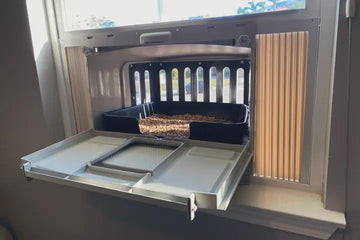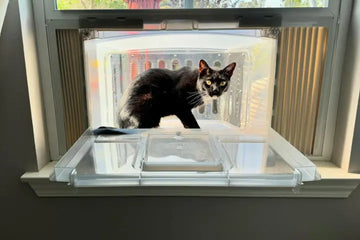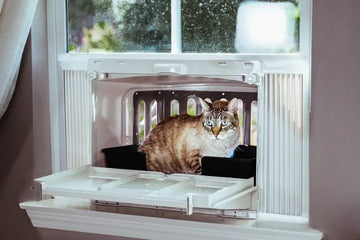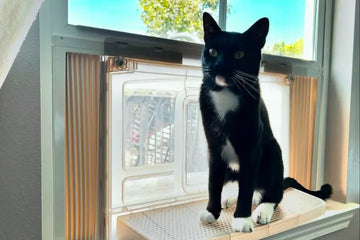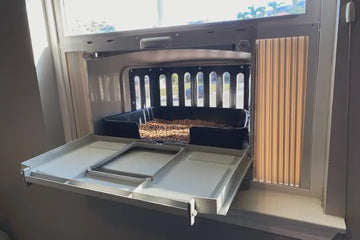Exercise is crucial to keep your cat fit. Without adequate physical activity, cats can develop various health issues such as obesity, joint problems, and even mental health challenges like anxiety and depression. Regular exercise helps to prevent these problems and keeps your cat agile and fit. It also plays a significant role in reducing unwanted behaviors that stem from boredom or excess energy, such as scratching furniture or aggressive play.

Interactive Play Sessions
Feather Wands
Feather wands are excellent tools for interactive play, helping to mimic the natural hunting behaviors that are instinctual to cats. Swinging these wands can stimulate your cat’s instinct to chase and pounce, providing a great cardiovascular workout. Engaging regularly in this type of play can enhance their agility and coordination, while also strengthening the bond between you and your pet. It's a simple yet effective way to keep your cat active and entertained.
Laser Pointer Play
Using a laser pointer can be another engaging way to help exercise for indoor cats. The unpredictable movements of a laser light mimic the motions of prey and can captivate your cat’s attention for extended periods. This type of play encourages cats to run, jump, and dart across the room, which is excellent for their physical fitness and mental alertness.
Battery-Operated Moving Toys
Battery-operated toys are perfect for keeping your cat engaged when you are busy or away. These toys move unpredictably, stimulating your cat’s natural hunting instincts and providing physical exercise without constant human intervention. They come in various forms, such as mice, balls, or even more elaborate robots that can navigate around obstacles, ensuring your cat remains active and curious.
Establishing a Playtime Routine
Creating a consistent playtime routine is crucial for keeping indoor cats active. Dedicate specific times of the day for play, ideally when your cat is most active, such as early morning or late evening. A routine helps your cat anticipate playtime, reducing anxiety and improving overall mood. Consistency also ensures that they get regular exercise, helping to prevent weight gain and maintain overall health.
Creating an Engaging Environment
Cat Trees and Climbing Towers
These structures provide multiple levels for climbing and exploration, which are vital for a cat’s physical health. By jumping from one level to another, cats engage their muscles and improve their balance. These structures often include scratching posts that help maintain healthy claws and allow cats to stretch their bodies fully.
Benefits of Vertical Spaces for Cats
By integrating various forms of vertical environments like shelves, trees, or furniture, cat owners can create a more stimulating and satisfying home for their feline companions. These spaces play a crucial role in fulfilling several key aspects of a cat's inherent behaviors and overall well-being. Here's a look at why vertical spaces are vital in indoor play for cats:
- Stress Reduction: Providing higher spaces for cats can be a major stress reliever, especially in homes with multiple pets or active households. Elevated spaces offer a retreat, allowing cats to observe their environment from a safe vantage point. This separation from ground-level stressors such as other animals, children, or loud noises helps cats feel more secure and less threatened. By having their own space, they can relax and decompress, reducing anxiety and improving their mental health.
- Territorial Control: Cats have an instinct to establish and oversee their territory. Vertical spaces cater to this need by giving them a high ground from which to survey their surroundings. Sense of ownership and oversight is crucial in multi-cat households, where conflicts can arise over territory. This elevated perspective not only helps maintain order but also gives cats a sense of empowerment and confidence in their environment.
- Enhanced Curiosity: Whether it’s watching birds outside a window, monitoring household activities, or simply enjoying a different view, these high perches can greatly enrich a cat’s environment. This stimulation is critical for their cognitive health, keeping their minds active and alert. It also reduces boredom, which can lead to destructive behaviors. By catering to their curiosity and providing opportunities for exploration and observation, vertical spaces help keep a cat’s life interesting and engaging.
Integrating vertical spaces into a home is more than just a luxury for a cat; it is an essential component of their living environment that caters to their instincts and enhances their quality of life.
Setting Up Shelves and Perches
Installing shelves and perches around your home can maximize the vertical space available for your cat. These installations should vary in height and position to encourage exploration and keep your cat guessing. They can be lined with soft materials for comfort or integrated into furniture like bookshelves or cabinets.
Puzzle Feeders and Treat-Dispensing Toys
Combining Mental and Physical Stimulation
Puzzle feeders and treat-dispensing toys are excellent tools for combining mental and physical stimulation in your cat's daily routine. These devices require your cat to solve simple puzzles or perform specific actions to release treats, engaging their problem-solving skills and persistence. In addition to giving them a physical component as they move about to obtain their rewards, this kind of stimulation is essential for maintaining their mental clarity and focus.
Types of Puzzle Feeders
There is a variety of puzzle feeders available on the market, each designed to target different aspects of your cat’s intelligence and physical abilities. Some require cats to move pieces around a board, others involve pushing levers or spinning wheels. The complexity can vary, which allows pet owners to choose a level that best suits their cat’s age, skill level, and interest.

Treat-Dispensing Toys
Introducing treat-dispensing toys should be a gradual process to ensure that your cat does not become frustrated. Start with simpler toys that are easy to understand and offer immediate rewards, which will help to build their confidence. As your cat becomes more accustomed to the idea of working for treats, you can gradually introduce more complex puzzles. Always ensure that the rewards are worth their effort, such as their favorite treats or small portions of their regular meals.
Agility Training for Indoor Cats
Setting Up a Simple Obstacle Course
It provides your feline friend with a stimulating activity and strengthens the bond between you and your pet as you interact and encourage them through the course. Here’s a guide on how to set up an effective and engaging obstacle course:
- Choose the Right Space: Begin by selecting an appropriate area in your home that provides ample space for your cat to maneuver. An empty hallway, a spacious living room, or a cleared-out area in a basement are ideal locations. The chosen space must be free of any hazards or obstructions that could interfere with your cat’s movement. This ensures the safety and allows your cat the freedom to explore and engage with the course without any restrictions.
- Use Safe Materials: Safety should always be a priority when setting up any play area for pets. Use soft, lightweight materials such as foam blocks, cardboard boxes, or soft pillows to construct the obstacles. Make sure that all elements are securely placed and will not tip over or collapse under your cat’s weight. Stable structures prevent accidents and create a safe environment where they can enjoy their feline indoor fitness worry-free.
- Incorporate Various Elements: To keep the obstacle course exciting and challenging, include a variety of components that encourage different movements. For instance, a low tunnel made from a cardboard box encourages crawling, while a line of staggered soft pillows can promote leaping and jumping. Variety not only helps in developing different muscle groups but also keeps your cat mentally stimulated and eager to explore each part of the course.
- Adjust Difficulty Gradually: It's crucial to tailor the difficulty level of the course to your cat’s abilities and confidence. Start with simpler, easier-to-navigate obstacles that your cat can master quickly. This initial success helps build their confidence. As they grow more comfortable and skilled, gradually introduce more complex challenges to the course to maintain their interest and encourage continuous improvement.
Setting up a home obstacle course for your cat is a wonderful way to enhance their physical abilities and mental acuity. By carefully planning the space, using safe materials, introducing varied elements, and adjusting the difficulty levels, you can provide fun and rewarding cat exercise activities.
Training with Tunnels, Hoops, and Cones
Using items like tunnels, hoops, and cones can make agility training more diverse and engaging for your cat. Tunnels can simulate the experience of hunting in confined spaces, hoops encourage jumping and precision, and cones can be used to teach weaving and quick directional changes. Training with these tools not only improves their physical capabilities but also helps to enhance their focus and obedience, making playtime both fun and beneficial.
Cat Fitness Tips
Setting up sessions correctly and following some key guidelines can make agility training a rewarding experience for both you and your cat. Here’s how to ensure that your agility sessions are successful:
- Warm Up Your Cat: Always start each agility session by warming up your cat with some gentle, stimulating play. This could involve a simple game of chasing a toy or light stretching movements that mimic parts of the agility course. Warming up helps prevent injuries by increasing your cat’s heart rate and loosening their muscles. It also prepares them mentally for the session, helping them focus and perform better on the course. This initial engagement is crucial for a productive training session.
- Use Positive Reinforcement: Cats respond well to positive reinforcement, so incorporate treats, verbal praise, or petting to encourage and reward your cat throughout the agility course. This not only motivates them but also reinforces their good behavior and successful navigation of the course. By associating agility tasks with positive outcomes, your cat will be more eager to participate and learn.
- Keep Sessions Short and Fun: Maintain your cat’s interest and enthusiasm by keeping the agility sessions short and engaging. Cats typically have short attention spans, so sessions that are too long may lead to boredom or frustration. Aim for sessions that are fun and lively, with enough variation to keep the training stimulating. Keeping the training light and enjoyable ensures that your cat remains interested and looks forward to each session.
- Be Patient and Adjust Difficulty: Agility training isn’t about pushing your cat to their limits from the start. Be patient and adjust the difficulty of the course according to your cat’s skills and comfort level. Start with easier obstacles and gradually increase the complexity as your cat becomes more confident and skilled. This approach ensures that each session is challenging yet achievable, providing a sense of accomplishment for your cat at each step.
These sessions not only help in developing your cat’s physical agility but also enhance their mental sharpness and deepen your relationship with them. As you both grow more accustomed to the training, you'll see notable improvements in your cat's agility and overall well-being, making the effort well worth it.
Using a Raised Litter Box
Benefits
A raised kitty litter box offers several advantages over traditional ground-level boxes. Elevating the box can reduce the strain on your cat’s joints, making it especially beneficial for older cats or those with mobility issues. This setup mimics the natural high perches cats seek for safety and observation, providing a sense of security and privacy. Moreover, a raised litter box can help keep the surrounding area cleaner, as litter is less likely to be tracked out of the box.
Types of Raised Cat Litter Boxes
There are various types of elevated cat litter boxes available, each designed to cater to different needs and preferences. Some models come with built-in steps, ideal for cats that cannot jump due to age or health issues. Others are designed with high sides to provide privacy and reduce litter spillage. When choosing a raised catio box, consider the height and ease of entry to ensure it suits your cat’s capabilities and needs.

Incorporating the Litter Box into Exercise
Positioning the lifted litter box in a way that requires some physical effort to reach can incorporate additional movement into your playful cat activities. For example, placing it on a platform that requires climbing can integrate a bit of a workout. Ensure the access route is safe and that your cat is comfortable with the arrangement to prevent any reluctance to use the box.
The goal of incorporating varied cat exercise routines is to ensure the long-term health and happiness of your indoor cat. Regularly assessing and adapting your approach to fit your cat's changing needs and preferences will help maintain their interest in staying active. A commitment to their physical and mental well-being will not only enhance their life but also enrich your relationship with them, making every day more enjoyable and fulfilling.



